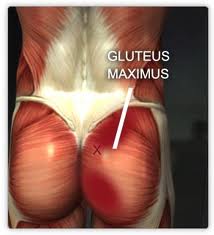A “Yoga Butt” may look great, but sometimes it hurts!
 Perhaps you’re familiar with a somewhat crass but amusing term “yoga butt”, which refers to a high, shapely and toned hind end. Example: “Wow! Check out her yoga butt-it looks great! You can tell she does a lot of yoga…”
Perhaps you’re familiar with a somewhat crass but amusing term “yoga butt”, which refers to a high, shapely and toned hind end. Example: “Wow! Check out her yoga butt-it looks great! You can tell she does a lot of yoga…”
But there is a dark side to the yoga butt. Over-zealous yoga practitioners, teachers in particular, will have a tendency to develop the type of yoga butt that means a painful, ouchy lower back. This has been a problem for me several times over the last few months, so I wanted to share with you some of the research and steps I am taking to avoid, or at least minimize the problem. It’s no fun being kept awake during much of the night by aching muscles.
Sciatica (pain of the sciatic nerve), concentrates in the lower back. Most people associate sciatica with a herniated disc, but you can suffer from this problem even with healthy discs. Other causes for the pain: strain on the Sacroiliac joints, (called “SI” joints for short) and/or piriformis (a lateral rotator muscle in the hip).
The kind of hypermobility yoginis tend to have can cause the SI joint to become unstable, and holding poses like crescent pose for a long time without properly stretching out the hips can lead to strain on the piriformis.
A typical sign of the SI joint being out of alignment is a pain on one side of the sacrum. Piriformis syndrome is present when the piriformis muscles in the upper glutes cause strain on the sciatic nerve. I’ve experienced both, sometimes simultaneously, as they can go hand in hand. I went in for a sports massage with Craig Burckes (thank god for that man), and without a doubt, there was a quarter-sized spot on both sides of my upper gluteal areas that were knots of pain, moreso on the right than left. He was able to help release the knots and pain through some firm acupressure applied to the point.
While massage therapy and ibuprofen will help once a problem has developed, what can we do to prevent the issue in the first place? Here are some recommended tips on prevention as well as caring for any pain that develops:
1) First of all, make your yoga practice less aggressive, and more consistent. I know that I approach my practice sometimes with too much zeal, and after 5 days off I go hog wild. Better to be doing a consistent but gentle practice every day, gently pushing yourself to your edge a little more each week. Be sure to thoroughly warm-up the hamstrings, spine and glutes before peforming more advanced poses involving these muscles. If these muscles are tight or weak they can affect the functioning of the SI joint.
2) My friend Sadie Nardini has a great little video covering this issue. She gives some tips, particularly engaging the navel to support the lower back and sit bones. Remember it’s all about supporting with the “core core core!” I’ve never injured my core, but I’ve easily hurt my lower back, so it makes sense the core is designed to support your overall bodily effort. Mula Bandha (the Root Lock, done by contracting and lifting the area bounded by the tailbone, pubic bones, and sitting bones) strengthens the pelvic floor muscles that help keep the lower end of the sacrum from lifting and the lower pelvic bones from spreading apart.
3) Ice. Ever notice how major league pitchers are icing their arms right up until they pitch, and then right after? They are protecting their arms as much as possible from inflammation. After your yoga practice, if several hours later you are starting to feel some strain, try placing a few bags of frozen peas over the sacrum for about ten minutes to help reduce swelling.
4) Massage–as mentioned above, some massage therapy, especially from a therapist who knows and works with yoga teachers, can help alleviate the pain. If you can’t afford a massage or can’t get time in your schedule for one, another thing you can try is lying on the floor with a tennis ball under you sacrum. Gently roll back and forth or in tiny circles, letting the tennis ball massage into that knot that has developed. Apply some ice afterward.
5) Some restorative yoga poses can really help soothe the pain. I recently tried the lying bent knee twist, as well as the technique of “resetting” my sacrum by supporting myself with a cork block. Those restorative techniques, plus a few others are documented here on this blog and should bring instant relief. Jason Crandell’s video podcast of a soothing evening yoga sequence has some great moves for putting the SI joint back into alignment, such as One-sided pelvic tilts, which involve reclining and drawing one bent knee toward the armpit on the same side. See this article on the yoga journal site for more poses like Lotus or backbends that may help ease the SI joints back into proper alignment. Other poses that can help: gentle backbends (cobra or sphinx), downard dog, spinal twists and child’s pose.
6) Finally, back off momentarily or proceed with caution on poses that aggravate a condition with your SI joints, such as seated forward bends, twists, and wide-legged poses.
McKenna Rowe is the Founder of Chakra 5 Mobile Yoga, an experienced team of corporate yoga instructors that provides mobile yoga classes on location and by appointment at businesses, schools and organizations throughout greater Los Angeles. Call us to start your corporate wellness program today: 310-853-3885.
